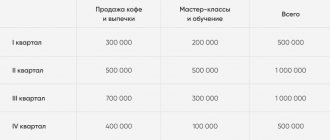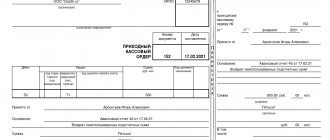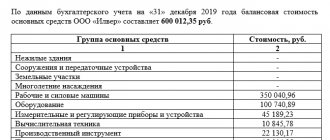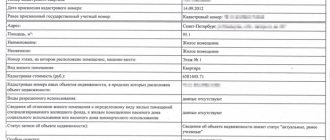Filling out forms 1.2 and 2.8 on the website www.reformagkh.ru
During the first quarter of 2015, organizations managing apartment buildings (management companies, homeowners' associations, housing cooperatives, residential complexes) are required to disclose certain types of information about the management of houses based on the results of 2015.
Since most of this information is financial in nature, the accountant will be involved in one way or another in preparing the data for publication. Let us remind you that in pursuance of the Information Disclosure Standard approved by Decree of the Government of the Russian Federation of September 23, 2010 No. 731, Order of the Ministry of Construction of the Russian Federation of December 22, 2014 No. 882/pr approved forms of information disclosure by organizations operating in the field of management of apartment buildings. This order came into force on May 25, 2015; disclosure of information based on the results of the year using these forms will be made for the first time. It often happens that even inspectors from state housing inspection bodies cannot answer specific questions from representatives of the Criminal Code about filling out certain lines, but this will not prevent them from imposing a fine in the future in case of an error.
Administrative liability for violation of information disclosure requirements.
Inappropriate (untimely, incomplete) disclosure of information may serve as a reason for bringing the management company to administrative liability for violation of licensing requirements (clause 6, part 1, article 193 of the Housing Code of the Russian Federation, part 2, article 14.1.3 of the Code of Administrative Offenses of the Russian Federation). In this case, an important point is to determine the statute of limitations for bringing to administrative responsibility. The obligation to fill out forms 1.2 and 2.8 (see pages 65 and 66, respectively) must be fulfilled during the first quarter of the year following the reporting year, that is, no later than 03/31/2016 (clause 9 (3) of the Information Disclosure Standard). Please note that the date of publication of information is recorded on the website www.reformagkh.ru. As explained in paragraph 14 of the Resolution of the Plenum of the Supreme Arbitration Court of the Russian Federation dated March 24, 2005 No. 5 and paragraph 19 of the Resolution of the Plenum of the Supreme Arbitration Court of the Russian Federation dated January 27, 2003 No. 2, failure to fulfill the obligation provided for by the said legal acts by the established deadline indicates that the administrative offense is not ongoing . The period for bringing to administrative responsibility is calculated from the day following the last day of the period provided for the performance of the relevant obligation, that is, from 04/01/2016.
According to Part 1 of Art. 4.5 of the Code of Administrative Offenses of the Russian Federation, the total period is three months, since cases of this category are considered by a judge (Part 1 of Article 23.1 of the Code of Administrative Offenses of the Russian Federation). It should be remembered that for some categories of cases the statute of limitations for bringing to administrative responsibility has been increased to a year, in particular, for violations of legislation on the protection of consumer rights. When considering cases of violation of the Information Disclosure Standard earlier (Article 7.23.1 of the Code of Administrative Offenses of the Russian Federation), some courts qualified the offense in this way and confirmed that the statute of limitations is equal to a year (see Resolution of the Supreme Court of the Russian Federation dated March 25, 2013 No. 3-AD13-2, AS SZO dated November 24, 2014 in case No. A26-592/2014, AS UO dated August 25, 2015 No. F09-5446/15). At the same time, there were opponents of this point of view (Resolution of the Federal Antimonopoly Service dated June 16, 2014 in case No. A12-24444/2013). Explanations on this issue can be found in paragraph 21 of the Resolution of the Plenum of the Supreme Arbitration Court of the Russian Federation dated June 2, 2004 No. 10. Thus, in the Code of Administrative Offenses of the Russian Federation, administrative offenses relating to consumer rights are not separated into a separate chapter, and therefore the courts, when qualifying the objective side of the offense, must proceed from its essence, the subject composition of the relations that have arisen and the nature of the applicable legislation. Courts must also take into account the purpose of legislation on the protection of consumer rights and its focus on protecting and ensuring the rights of citizens to purchase goods (work, services) of adequate quality and safe for life and health, obtain information about goods (work, services) and their manufacturers (performers, sellers). In this sense, courts must determine whether the protection of consumer rights is the priority goal of the law regulating relations for which administrative liability is established. Thus, there is a risk that a violation of licensing requirements, expressed in untimely disclosure of information, may be qualified as a violation of legislation in the field of consumer protection. And then the statute of limitations for bringing to justice will expire on 04/01/2017.
As for non-profit associations of citizens, they are not subject to liability for improper disclosure of information in accordance with the requirements of the relevant standard. Until May 1, 2015, Art. 7.23.1 of the Code of Administrative Offenses of the Russian Federation, which established liability for organizations carrying out activities to manage apartment buildings on the basis of management agreements. Despite the fact that the HOA does not enter into management agreements as an executor, there are cases when this responsibility was applied to it (Resolution of the Supreme Court of the Russian Federation dated December 22, 2015 No. 303-AD15-11489, AS UO dated December 3, 2014 No. F09-8335/14) .
General information about the management company
Name of company
Full official: Closed Joint Stock Company Repair and Construction
Abbreviated form: CJSC RSF "Remstroyservice"
CEO
Belyaeva Lyudmila Vasilievna
Address (legal, actual and postal)
129110, Moscow, Orlovo-Davydovsky lane, 2/5, building 3
Operation site office: 129110, Moscow, Shchepkina st., 60/2 building 2
Bank details
Corr./account 30101810400000000225 at Sberbank of Russia OJSC
BIC 044525225
TIN 7702019661
Gearbox 770201001
Calc. account 40702810538090104977
Details of the certificate of state registration of a legal entity
CJSC RSF "Remstroyservis" was registered by the State Institution of the Moscow Registration Chamber on 08/01/1994 No. 032967 with the main state registration number 1037739025906 date of entry 01/08/2003 by the Interdistrict Inspectorate of the Ministry of Taxes of Russia No. 39 for Moscow
Form 1.2
Information on the main indicators of the financial and economic activities of management companies, homeowners' associations, and residential complexes is presented for the reporting period - a calendar year, therefore, the start date of the reporting period is 01/01/2015, the end date of the reporting period is 12/31/2015.
First of all, the manager needs to attach a scanned copy of the annual financial statements document for the reporting period in the form of files in electronic form (line 4). This means that all pages of the annual financial statements, to the extent required by accounting legislation and accounting policies, should be scanned and placed as a single document in the appropriate field when filling out the form. Reporting can be posted immediately after preparation (that is, after a paper copy has been signed by the head of an economic entity [1]), without approval by the company’s participants. This applies to both management companies and non-profit associations of citizens.
How to respond to public inquiries
Citizens can send written requests by mail or email to their property management company to obtain information about its activities or their home. The management company, in turn, must respond to these requests from citizens within 10 working days from the date of receipt of the request. All requests received by regular mail or email are stored by the Management Company for 5 years.
In the electronic response, the management company must duplicate the text of the request itself, as well as provide the requested information. Be sure to indicate the name and position of the management company employee who responded to the request.
If the request was received by regular mail, then it must be registered on the day it was received, assigned a registration number and stamped by the Criminal Code. The written response must include the same information as provided electronically.
A citizen who sends you a written request must indicate the name of your management company, his full name, postal address, state the essence of his request, and also indicate the desired method of receiving a response: by mail or hand-delivered.
Income and expenses.
The next two lines are information about income (expenses) received (incurred) for the provision (in connection with the provision) of services for managing apartment buildings (according to separate accounting of income and expenses). When filling out these indicators, you need to consider that:
- in this form the data is reflected in total for all houses under management;
- here it is logical to disclose information on all services and work provided and performed on the basis of management contracts (not only on direct management services of apartment buildings, but also on utilities, as well as on the maintenance and current repairs of common property);
- since income and expenses are an accounting object, it is logical to assume that the indicators should be taken from accounting;
- One more thing follows from the previous provision: for a company paying VAT on the transactions in question, income should be shown excluding VAT (clause 3 of PBU 9/99 “Income of the organization”);
- Separate accounting refers to accounting methods by which income and expenses within the framework of MKD management activities are separated from other income and expenses.
Income related to the provision of services for the management of apartment buildings (line 5) certainly includes the amounts of fees accrued to the owners (tenants) of premises for utilities, maintenance of common property, management of apartment buildings, that is, revenue for the provision of services, performance of work, recognized in current period. From a taxation point of view, proceeds for current repairs qualify as funds for targeted financing (clause 14, paragraph 1, article 251 of the Tax Code of the Russian Federation), subject to separate accounting and targeted use. In accounting, revenues for current repairs can be classified as earmarked funds if they are collected in approximately the same way as contributions to the capital repair fund: detailed repair parameters are not agreed upon in advance. If, when making a decision to pay for current repairs, deadlines, lists and costs of work are established, we propose to generate future income. The disclosed indicator should most likely include revenue from the provision of services and performance of work (turnover on the credit of account 90 “Sales” for the reporting period). For the same reason, accrued contributions for capital repairs are not included in income if the fund is formed in a special account.
Income received for the provision of apartment building management services should be distinguished from revenue from the provision or performance of other services or work (renting out property, carrying out work on private property or individual work under contract agreements outside of apartment building management agreements). In addition, any company has a lot of other income, one way or another due to its core activities, for example, amounts of penalties received from unscrupulous payers, compensation for damage caused, interest on the use of the balance of free funds in the account, commissions from partners (if, to for example, the management company for a fee charges and collects payments from the population for the services of third-party organizations), intermediary remuneration from the owners of premises (for example, for participation on behalf of the owners of premises in a lease agreement for common property, in calculations related to the payment of remuneration to members of the council of MKD), etc. They can hardly be considered directly received for the provision of services for the management of apartment buildings. Therefore, such income should be separated in accounting and should not be included in Form 1.2.
In turn, in connection with the receipt of these incomes, the company inevitably incurs expenses (line 6). Some of them can be directly correlated with certain income, and some relate to several types of activities at once. In this case, separate cost accounting consists of a forced (calculated) distribution of the second part of the costs by type of activity. The method of distribution of expenses must be specified in the local act of the organization. Please note that direct costing can be adopted in accounting - a method of cost accounting in which the company does not determine the full cost of services and work, but writes off commercial and administrative expenses without distributing the total amount (paragraph 2 of clause 9 of PBU 10/99 "Organization expenses"). The need to disclose expenses in Form 1.2 does not mean that the organization must change the accounting method of recognizing expenses. It seems that the management company has the right to approve a special methodology for allocating costs for the purposes of information disclosure and, in accordance with it, calculate the indicator included in form 1.2 on line 6.
Another question that arises in practice: is a homeowners association (housing association, housing complex) required to fill out the indicators under consideration (information on income and expenses in connection with the provision of apartment building management services)? The fact is that, depending on the accounting policy of the partnership, the answer to the question of whether receipts from the owners of premises in reimbursement of expenses for the maintenance and current repairs of common property, payment for utilities are income in accounting, may be different. Many partnerships do not record revenue from the provision of services either in accounting or tax accounting. However, in the Housing Code you can find wording from which it is clear that the HOA still provides services (Part 2 of Article 143.1). In addition, from the literal interpretation of paragraphs. “a” clause 3 of the Information Disclosure Standard does not mean that partnerships and cooperatives are exempt from disclosing the main indicators of their financial and economic activities, including information on income and expenses associated with apartment management services. Also in Form 1.2 there are two footnotes to lines 17 (estimate of income and expenses of a partnership or cooperative) and 18 (report on the implementation of the said estimate), according to which this information is subject to disclosure for partnerships and cooperatives. This means that no exception forms have been established for other indicators.
Thus, the HOA should enter in line 5 (income) the amount of payments accrued to the owners and tenants of premises (both members and non-members) for the maintenance and repair of common property and utilities, and in line 6 (expenses) - all expenses incurred for the purpose of maintaining and repairing common property and providing utilities.
LIST OF HOUSES IN MANAGEMENT
At the moment, CJSC RSF "Remstroyservice" manages 63 houses.
In 2021, management contracts for apartment buildings were not terminated.
Register of apartment buildings managed by CJSC RSF "Remstroyservice" on the basis of a management agreement
| No. | Address of the apartment building | No. ODS, address and telephone | Total area of residential and non-residential premises, sq.m. | Management agreement details | Second party to the management agreement |
| 1 | Bolnichny Lane d.1 | ODS No. 5, Trifonovskaya st. 61 building 1, tel.8 | 824,70 | w/n dated 01/01/2009 | premises owners |
| 2 | Bolnichny Lane D 2 | ODS No. 5, Trifonovskaya st. 61 building 1, tel. | 688,30 | w/n dated 01/01/2009 | premises owners |
| 3 | Verzemneka st. d.1 | ODS No. 6, Trifonovskaya st. 61, building 1 tel. | 2 865,30 | w/n dated 01/03/2008 | premises owners |
| 4 | Verzemneka st. D 2 | ODS No. 6, Trifonovskaya st. 61, building 1 tel. | 3 523,90 | w/n dated 01/05/2007 | premises owners |
| 5 | Verzemneka st. d.2a p.1 | ODS No. 6, Trifonovskaya st. 61, building 1 tel. | 5 303,60 | w/n dated 01/05/2007 | premises owners |
| 6 | Verzemneka st. d.3 | ODS No. 6, Trifonovskaya st. 61, building 1 tel. | 3 400,30 | w/n dated 01/03/2008 | premises owners |
| 7 | Verzemneka st. d.5 | ODS No. 6, Trifonovskaya st. 61, building 1 tel. | 3 444,30 | w/n dated 01/03/2008 | premises owners |
| 8 | Verzemneka st. D 7 | ODS No. 6, Trifonovskaya st. 61, building 1 tel. | 3 302,50 | w/n dated 01/04/2008 | premises owners |
| 9 | Vypolzov Lane d.6 | ODS No. 5, Trifonovskaya st. 61 building 1, tel. | 3 592,30 | w/n dated 10/01/2012 | premises owners |
| 10 | Vypolzov Lane d.8 | ODS No. 5, Trifonovskaya st. 61 building 1, tel. | 2 041,90 | w/n dated 03/01/2008 | premises owners |
| 11 | Vypolzov Lane building 10 | ODS No. 5, Trifonovskaya st. 61 building 1, tel. | 3 629,60 | w/n dated 01/03/2008 | premises owners |
| 12 | Gilyarovskogo st. building 33 | ODS No. 5, Trifonovskaya st. 61 building 1, tel. | 3 820,90 | w/n dated 01/04/2008 | premises owners |
| 13 | Gilyarovskogo st. 36 building 1a | ODS No. 5, Trifonovskaya st. 61 building 1, tel. | 4 001,10 | w/n dated 01/04/2008 | premises owners |
| 14 | Gilyarovskogo st. building 44 | ODS No. 5, Trifonovskaya st. 61 building 1, tel. | 6 554,40 | w/n dated 01/07/2008 | premises owners |
| 15 | Gilyarovskogo st. d.45 | ODS No. 5, Trifonovskaya st. 61 building 1, tel. | 3 644,60 | w/n dated 01/05/2009 | premises owners |
| 16 | Gilyarovskogo st. d.59 | ODS No. 5, Trifonovskaya st. 61 building 1, tel. | 10 692,50 | w/n dated January 10, 2007 | premises owners |
| 17 | Gilyarovskogo st. 60 building 1 | ODS No. 5, Trifonovskaya st. 61 building 1, tel. | 599,50 | w/n dated 01/02/2009 | premises owners |
| 18 | Gilyarovskogo st. 60 building 2 | ODS No. 5, Trifonovskaya st. 61 building 1, tel. | 1 598,40 | w/n dated 01/02/2009 | premises owners |
| 19 | Golyanovskaya 1B | ODS No. 18, Semenovskaya emb. 2/1, tel. | 3 660,80 | w/n dated 02/01/2014 | premises owners |
| 20 | Hospital shaft. 3 building 3 | ODS No. 18, Semenovskaya emb. 2/1, tel. 8 | 7 375,00 | w/n dated 08/01/2017 | premises owners |
| 21 | Kapelsky lane building 13 | ODS No. 5, Trifonovskaya st. 61 building 1, tel. | 2 608,90 | w/n dated 04/01/2008 | premises owners |
| 22 | Mira Ave. building 27 | ODS No. 5, Trifonovskaya st. 61 building 1, tel. | 3 250,00 | w/n dated 01/05/2007 | premises owners |
| 23 | Mira Ave. building 29 | ODS No. 5, Trifonovskaya st. 61 building 1, tel. | 3 372,90 | w/n dated January 11, 2007 | premises owners |
| 24 | Mira Ave. d.45 | ODS No. 5, Trifonovskaya st. 61 building 1, tel. | 4 164,40 | w/n dated January 15, 2007 | premises owners |
| 25 | Mira Ave. 51 building 1 | ODS No. 5, Trifonovskaya st. 61 building 1, tel. | 5 966,90 | w/n dated January 23, 2007 | premises owners |
| 26 | Mira Ave. 53 building 1 | ODS No. 5, Trifonovskaya st. 61 building 1, tel. | 2 825,80 | w/n dated January 12, 2007 | premises owners |
| 27 | Mira Ave. 55 building 1 | ODS No. 5, Trifonovskaya st. 61 building 1, tel. | 1 857,20 | w/n dated 01/05/2007 | premises owners |
| 28 | Mira Ave. d.68 | ODS No. 8, Mira Avenue, 74 tel. | 12 738,70 | w/n dated December 28, 2008 | premises owners |
| 29 | Mira Ave. 71 building 1 | ODS No. 5, Trifonovskaya st. 61 building 1, tel. | 8 481,10 | w/n dated January 16, 2007 | premises owners |
| 30 | Mira Ave. building 73 | ODS No. 5, Trifonovskaya st. 61 building 1, tel. | 7 391,50 | w/n dated January 10, 2009 | premises owners |
| 31 | Mira Ave. building 77, building 1 | ODS No. 5, Trifonovskaya st. 61 building 1, tel. | 1 044,40 | w/n dated 01/02/2009 | premises owners |
| 32 | Mira Ave. d.79 | ODS No. 5, Trifonovskaya st. 61 building 1, tel. | 18 922,50 | w/n dated January 22, 2008 | premises owners |
| 33 | Olympic Avenue building 22 | ODS No. 6, Trifonovskaya st. 61, building 1 tel. | 43 819,00 | w/n dated 01/08/2008 | premises owners |
| 34 | Olympic Avenue building 24 | ODS No. 6, Trifonovskaya st. 61, building 1 tel. | 6 005,70 | w/n dated 02/01/2008 | premises owners |
| 35 | Olympic Avenue 26 building 1 | ODS No. 6, Trifonovskaya st. 61, building 1 tel. | 18 584,90 | w/n dated 01/02/2009 | premises owners |
| 36 | Olympic Avenue building 28 | ODS No. 6, Trifonovskaya st. 61, building 1 tel. | 5 948,40 | w/n dated 01/05/2008 | premises owners |
| 37 | Orlovo-Davydovsky lane. 2/5 building 1 | ODS No. 18, Botanichesky lane. eleven, tel. | 7 346,70 | w/n dated March 12, 2008 | HOA |
| 38 | Orlovo-Davydovsky lane. building 2/5 building 2 | ODS No. 18, Botanichesky lane. eleven, tel. | 3 098,10 | w/n dated 01/06/2009 | premises owners |
| 39 | Orlovo-Davydovsky lane. building 2/5, building 3 | ODS No. 18, Botanichesky lane. eleven, tel. | 4 029,00 | w/n dated 10/16/2008 | HOA |
| 40 | Pereyaslavskaya B. 19 | ODS No. 6, Trifonovskaya st. 61, building 1 tel. | 9 261,40 | w/n dated 01/01/2013 | premises owners |
| 41 | Semenovskaya embankment d.2/1 p.1 | ODS No. 18, Semenovskaya emb. 2/1, tel. | 20 139,00 | w/n dated 12/01/2015 | premises owners |
| 42 | Semenovskaya embankment building 3/1 building 3 | ODS No. 18, Semenovskaya emb. 2/1, tel. | 5 807,00 | w/n dated 07/01/2015 | premises owners |
| 43 | Semenovskaya embankment 3/1, building 4 | ODS No. 18, Semenovskaya emb. 2/1, tel. | 11309,00 | w/n dated 05/01/2016 | premises owners |
| 44 | Semenovskaya embankment 3/1, building 5 | ODS No. 18, Semenovskaya emb. 2/1, tel. | 9 666,90 | w/n dated 08/01/2014 | premises owners |
| 45 | Semenovskaya embankment 3/1, building 6 | ODS No. 18, Semenovskaya emb. 2/1, tel. | 24 815,80 | w/n dated 02/01/2014 | premises owners |
| 46 | Suschevsky Val, 60, building 1 | ODS No. 6, Trifonovskaya st. 61, building 1 tel. | 2 639,90 | w/n dated January 22, 2009 | premises owners |
| 47 | Suschevsky Val, 60, building 2 | ODS No. 6, Trifonovskaya st. 61, building 1 tel. | 3 394,70 | w/n dated 01/01/2009 | premises owners |
| 48 | Suschevsky Val 62 | ODS No. 6, Trifonovskaya st. 61, building 1 tel. | 7 866,60 | w/n dated 01/01/2009 | premises owners |
| 49 | Suschevsky Val 66 | ODS No. 6, Trifonovskaya st. 61, building 1 tel. | 11 220,90 | w/n dated 01/04/2009 | premises owners |
| 50 | Trifonovskaya st. d.45 | ODS No. 6, Trifonovskaya st. 61, building 1 tel. | 10 297,40 | w/n dated 01/05/2007 | premises owners |
| 51 | Trifonovskaya st. d.45a | ODS No. 6, Trifonovskaya st. 61, building 1 tel. | 3 458,30 | w/n dated 01/09/2008 | premises owners |
| 52 | Trifonovskaya st. d.47a | ODS No. 6, Trifonovskaya st. 61, building 1 tel. | 3 406,60 | w/n dated 01/05/2008 | premises owners |
| 53 | Trifonovskaya st. d.47b | ODS No. 6, Trifonovskaya st. 61, building 1 tel. | 3 523,20 | w/n dated 01/01/2009 | premises owners |
| 54 | Trifonovskaya st. building 49 | ODS No. 6, Trifonovskaya st. 61, building 1 tel. | 8 499,50 | w/n dated 01/02/2008 | premises owners |
| 55 | Trifonovskaya st. building 54, building 1 | ODS No. 5, Trifonovskaya st. 61 building 1, tel. | 5 629,70 | w/n dated 01/02/2008 | premises owners |
| 56 | Trifonovskaya st. building 54, building 2 | ODS No. 5, Trifonovskaya st. 61 building 1, tel. | 4 643,20 | w/n dated 01/02/2008 | premises owners |
| 57 | Trifonovskaya st. d.55 | ODS No. 5, Trifonovskaya st. 61 building 1, tel. | 4 151,00 | w/n dated 01/06/2007 | premises owners |
| 58 | Trifonovskaya st. d.56 | ODS No. 5, Trifonovskaya st. 61 building 1, tel. | 14 111,10 | w/n dated January 25, 2008 | premises owners |
| 59 | Trifonovskaya st. building 61, building 1 | ODS No. 5, Trifonovskaya st. 61 building 1, tel. | 10 551,90 | w/n dated January 21, 2008 | premises owners |
| 60 | Shchepkina st. d.60/2 building 1 | ODS No. 5, Trifonovskaya st. 61 building 1, tel. | 6 816,10 | w/n dated 01/04/2007 | premises owners |
| 61 | Shchepkina st. building 62 | ODS No. 5, Trifonovskaya st. 61 building 1, tel. | 1 010,70 | w/n dated January 25, 2007 | premises owners |
| 62 | Shchepkina st. 64 building 1 | ODS No. 5, Trifonovskaya st. 61 building 1, tel. | 3 645,30 | w/n dated January 16, 2007 | premises owners |
| 63 | Shchepkina st. 64 building 2 | ODS No. 5, Trifonovskaya st. 61 building 1, tel. | 4 607,60 | w/n dated January 19, 2008 | premises owners |
| Total | |||||
Estimate and report on its implementation.
In lines 17 and 18 of Form 1.2, the HOA (cooperative) must (must) attach scanned copies of the estimate of income and expenses for the reporting period, a report on its implementation in the form of files in electronic form.
Current legislation does not offer HOAs a universal form of income and expense estimates. Therefore, it is unlikely that inspectors will be able to reasonably make claims against its content.
All legal regulation comes down to clauses 2, 3, part 1, art. 137 of the Housing Code of the Russian Federation, from which it follows that:
- an estimate of income and expenses is drawn up for the year;
- the estimate includes, among other things, the necessary costs for the maintenance and repair of common property in the apartment building, costs for major repairs and reconstruction of the house, special contributions and deductions to the reserve fund, as well as costs for other purposes provided for by law and the charter of the partnership;
- on the basis of the accepted estimate, the amounts of payments and contributions are established for each owner of the premises in the apartment building in accordance with his share in the common property right.
It seems that the basis for drawing up cost estimates should be the annual plan for the maintenance and repair of common property (Clause 8, Part 2, Article 145 of the RF Housing Code), which describes the necessary work and services. The cost estimate for maintenance and ongoing repairs is the monetary expression of the specified plan. Having received the amount of planned expenses, you should evaluate possible revenues, ultimately calculating the main one - payments from property owners. The form of the estimate is arbitrary, the list of expenses is predetermined by the cost structure of each specific HOA (contract work by type, personnel costs, material costs, maintenance of the partnership premises, etc.).
The report on the implementation of the estimate contains real indicators for planned items and deviations from the plan. It seems that it would be logical, as an explanation to the report, to set out the reasons for overexpenditures and savings. By default, the annual general meeting of HOA members, at which the estimate report is approved, is held in the second quarter of the next year (Part 1, Article 45, Part 1.1, Article 146 of the Housing Code of the Russian Federation), that is, after the deadline for disclosing the relevant information. This means that decisions of the highest governing body of the HOA on issues of overexpenditure and savings will be published later.
Debt to RSO.
The largest number of lines of Form 1.2 is devoted to the disclosure of information in the housing and communal services sector, namely data on the amounts of debt of the management company (HOA, housing complex) to the RSO, both in total (line 7) and broken down by type of utility resources (lines 8 – 16):
- thermal energy (separately for heating and hot water supply);
- hot water;
- cold water;
- drainage;
- gas;
- Electric Energy;
- other resources (services).
When filling out these indicators, you need to pay attention to the following features:
- the explanations for filling out Form 1.2 indicate that information in the housing and communal services sector is subject to disclosure of debt for the reporting period, however, the debt indicator is an indicator characterizing the financial position of the company as of the reporting date, and not the results of its activities for the period. Therefore, the wording “debt for the reporting period” is meaningless; we believe that the debt should be disclosed as of the end of the reporting period, that is, as of December 31, 2015;
- if the same resource is supplied by several distribution centers (for example, to different houses), the debt indicators should be summed up;
- the explanation to the form says: in the case of direct supply of a utility resource to consumers, a zero value is indicated. Currently, direct relations between consumers and RSO are possible in the cases described in Part 17 of Art. 12 of the Federal Law of June 29, 2015 No. 176-FZ. Here the manager really has no debt to the RSO. But in the case of direct payments for a particular utility service by decision of the general meeting in the accounting of the management company (HOA), the debt to the RSO is formed in the general manner, so the indicator must be disclosed;
- the debt indicator includes not only the unpaid cost of a utility resource, but also usually “input” VAT (turnover on the credit of accounting account 60). This means that in Form 1.2 the debt should be shown in full; this does not in any way affect the manager’s use of VAT deductions.
The only source of indicators of debt to RSO are accounting registers, information into which comes from primary documents. Before preparing financial statements, organizations are required to reconcile settlements with counterparties, but the accounting reflects data that the organization considers correct (clause 73 of the Regulations on accounting and financial reporting in the Russian Federation, approved by Order of the Ministry of Finance of the Russian Federation dated July 29, 1998 No. 34n). You should not mechanically transfer RSO data from the reconciliation of calculations to Form 1.2 (inflated erroneous indicators are possible).
Who makes the decision
The reporting organization determines the degree of limitation of the disclosed information independently, based on the specific conditions and circumstances of its business activities, its counterparties, and related parties.
Order of the Ministry of Finance dated November 27, 2020 No. 287n refers only to limiting the volume of disclosed information, and not to excluding it from reporting completely.
The management of the organization decides:
- about the existence of a situation in which limited disclosure of information is necessary;
- what limited information to disclose;
- about the extent of such restrictions.
Form 2.8.
Unlike the data disclosed in Form 1.2, the report in Form 2.8 is completed in relation to each house managed by the company separately. If we are talking about an HOA created to manage one house, some indicators of forms 1.2 and 2.8 may coincide. By the way, please note that Form 2.8 is called “Report on the execution by the management organization of the management agreement, as well as a report on the fulfillment by the partnership or cooperative of estimates of income and expenses for the year.” Management companies, having completed such a report for the purpose of disclosing information in the housing and communal services sector, are simultaneously considered to have fulfilled the obligation to submit a report to the owners on the basis of Part 11 of Art. 162 of the Housing Code of the Russian Federation, unless, of course, a different form of the report was provided for in the MKD management agreement.
On the other hand, does this mean for the HOA that the report on the implementation of the estimate, which must be placed in form 1.2, should be taken in the form of form 2.8? It seems that the authorities had no intention of duplicating information on the same source (www.reformagkh.ru), so the conclusion drawn is not an imperative requirement. The estimate report is drawn up on the basis (in the form) of the estimate, which cannot correspond to Form 2.8 for HOAs, at least because it includes details of the costs of maintaining personnel, the acquisition of fixed assets of the HOA, etc.
Maintenance and current repairs: charges and receipts.
The first part of Form 2.8, which has the subtitle “General information on the work performed (services provided) for the maintenance and current repairs of common property in the apartment building,” provides data on the amounts accrued to consumers and the funds actually received by the manager. When filling out any line, specifying a zero value is allowed. This is possible if the manager does not have the necessary detail of data or no operations have occurred. We draw special attention to the fact that this section does not reflect information related to contributions for major repairs of common property. Among the disclosed indicators:
- advance payments by consumers (at the beginning and end of the period) (lines 4 and 18), which mean the funds actually contributed by consumers in excess of those accrued by the reporting date;
- consumer debt (also at the beginning and end of the period) (lines 6 and 20) - the amount of outstanding debt of consumers using premises in a particular apartment building for services (work) for the maintenance and current repairs of common property in the apartment building. We especially emphasize: indicators for both advances and debt can be filled in at the same time, because some consumers in the house may pay for services in advance, while others may have debt. This consideration once again confirms that combining the population into a single customer in the accounting program does not eliminate the need to accumulate information on calculations for each consumer;
- accrued for services (work) for maintenance and routine repairs in total (line 7) and including a breakdown for house maintenance, routine repairs, and management services separately (lines 8, 9, 10). These indicators correspond to the turnover for the year in the debit of account 62 (according to the corresponding subaccounts). Let us emphasize once again that it is allowed to specify a null value in any of the lines of the form. This means that if accruals in accounting were carried out in a single amount - for the maintenance of common property, in the report on Form 2.8 only one line 8 “For the maintenance of the house” will be filled in. This procedure does not violate the rights of citizens;
- funds received for the reporting period for the house for the provision of services for the maintenance and current repairs of common property (the total indicator cannot take a zero value) (line 11). This indicator is determined by comparing the turnover in the debit of account 51 and the credit of the account for accounting for settlements with consumers for maintenance and current repairs (the corresponding analytical account opened to account 62). By the way, if settlements with consumers are carried out through third parties, and the manager issues instructions to the latter to transfer money directly to suppliers and contractors (that is, only a small part of the funds ends up in the manager’s account), the manager is obliged to show receipts from consumers in full (according to the report of the paying agent ). In this case, to fill out this line of the report, you should analyze the accounting entries for the debit of the account for accounting for settlements with the paying agent and the credit for the account for accounting for settlements with consumers.
In practice, the question arises why the indicator “Cash received” has a different level of detail than the indicator “Accrued for services (work)”. In particular, revenues should be differentiated by sources (lines 12 – 16):
- funds from owners and tenants of premises;
- targeted contributions from owners and tenants of premises;
- subsidies;
- funds from the use of common property;
- other supply.
However, it does not follow from the form that incoming funds must cover exactly the amounts accrued to consumers for services (work). For example, when receiving a subsidy for improvement of the local area, the management company does not charge consumers (owners, tenants of premises) a fee for its work. Another case: funds from the rental of common property, by decision of the general meeting, allocated for the maintenance of common property in the apartment building, are first accumulated and only after the meeting makes a decision are used. Regarding target contributions (line 13), it seems that this line is most relevant for HOAs. Let us note that all these funds must be associated specifically with the provision of services and the performance of work on common property. For example, targeted contributions from the owners of common property as a whole may include payments intended to pay remuneration to members of the MKD council. However, these amounts are not related to the provision of management services, so they are not included in the report.
The largest number of questions is raised by filling out the line “Carrying-over cash balances” (shown at the beginning and end of the period) (lines 5 and 19). The developers of information disclosure forms provided the following explanation. The amount of money unused for the previous reporting period under the apartment building is indicated, formed as a result of payment by consumers for services (work) for the maintenance and routine repairs of common property in the apartment building and transferred to the next reporting period. Most likely, this refers to fees for funds that will obviously be used in subsequent periods. A classic example is the capital repair fund; however, we repeat, due to special regulations, calculations related to the filling and use of the capital repair fund are not disclosed in Form 2.8. For an HOA, these can be any trust funds created by decision of the general meeting of members in accordance with the charter. For a management company, the carryover balance is funds that are received by it, but cannot be spent in the reporting period when they were received. For example, these are funds from the use of common property by third parties, if the general meeting decided to accumulate them. The same applies to contributions to the current repair fund provided for by the decision of the general meeting. Carry-over balances do not belong to the manager and, when changing the management method, they can be claimed by the new manager on behalf of the owners of the premises in the apartment building.
The last indicator that I would like to pay attention to is “Total cash, taking into account balances” (line 17). It reflects the total amount of funds that were at the disposal of the manager during the reporting period and were intended for the maintenance and ongoing repairs of common property. It seems that it is incorrect to consider the amount of money as the amount that the manager must spend on the maintenance and ongoing repairs of the house. It can be stated with 100% certainty that the manager’s expenses (recognized by the accrual method as the occurrence of liabilities) will not coincide with the amount of funds under consideration. But there is no violation in this. In all likelihood, this indicator can make it possible to clearly assess the financial position of the manager, since the most popular justification for violations in the area of maintaining common property is lack of funding.
Maintenance and current repairs of common property: types of work and their cost.
Lines 21 – 26 of Form 2.8 must provide information about the work performed, services provided and their annual cost. Please note that the list of works is entered on the website www.reformagkh.ru in form 2.3, and in form 2.8 it is displayed automatically. The actual annual cost of work (services), which should be entered in line 22, means the cost of such work (services) for consumers. If the work (service) is completed (provided) in full, its actual cost must correspond to the planned cost. From the sum of the annual actual cost of all work (services), obviously, the total indicator of the fee accrued for the year for the maintenance of residential premises should be obtained. It seems that the management company has no reason to show actual costs, either if they exceed the fee agreed upon with the owners of the premises (after all, the compliance of the established fee with the actual cost of mandatory measures is the risk of the management company), and if the actual costs are less than the price of the work ( services) (this difference represents the profit of the management company). In the case of a non-profit association (HOA, LCD), on the contrary, the annual actual cost of work (services) is nothing more than the actual costs of their implementation (provision).
Next, it is necessary to detail the above works (services) by type, if possible. In the explanations to all lines where you need to reflect information about the types of work (. Please note that for detailed work (services) there is no need to provide the annual cost, sufficient information is the frequency of work (services) (for example, annually, weekly, continuously) , unit of measurement (number of times, sq. m. area of premises), cost per unit of measurement.
Please note that the management company usually calculates the cost of services per 1 sq.m. for clients. m area of premises in the house. However, it appears that such value does not always need to be disclosed on line 26 of Form 2.8. This is due to the fact that the unit of measurement of the volume of work (service) can hardly be the area of premises owned by the owners in the apartment building. For example, if we are talking about a cleaning service for common areas, the unit of measurement is 1 sq. m of harvesting area. It is advisable to evaluate the elevator maintenance service per elevator, snow removal - by volume (cubic meters) of snow removed, annual inspections - in times, the service for holding a general meeting of premises owners - per one meeting, taking into account the number of premises owners in this house. In other words, these indicators (unit of measurement of the volume of work (service) and cost per unit of measurement) should be borrowed from contracts with contractors who directly perform the work and provide services.
Consumer complaints.
In the corresponding section of Form 2.8 (lines 27 – 30) you should indicate information about the claims of all owners of premises in the apartment building (regardless of the status of the premises) regarding the quality of work performed (services provided) for the maintenance and routine repairs of common property. It seems that this should also include claims related to violation of the frequency of work (see Rules for changing the amount of fees for the maintenance and repair of residential premises, approved by Decree of the Government of the Russian Federation of June 13, 2006 No. 491). Line 30 of Form 2.8 indicates the amount of recalculation made based on the results of satisfying consumer claims. It is logical to assume that the report for 2015 should include the amounts of recalculation made this year. We would like to add that management companies often carry out recalculation due to unlawfully inflating fees for the maintenance of residential premises, but these amounts are not included in this section.
Where should information on the Standard be posted?
Mandatory sources are also defined for this:
- official website of Housing and Communal Services Reform
- management company website
- information stand at the company office
Information that is posted in all these sources according to disclosure forms approved by the Ministry of Construction must be accessible and stored for 5 years. For the older generation, who do not know how to use interactive resources, printed forms are provided on information stands in the company’s office.
The management company must publish its annual report annually in the first quarter following the previous reporting period. That is, by March 31, 2021, you already have to submit your annual report for 2015. You can read more about this in the first and second parts of the series of articles devoted to this topic.
If any changes have occurred in the activities of the management company, they must be reflected on official websites on the Internet within 7 working days from the date of the change and on information stands - within 10 working days. If a new house has been transferred to the management of the management company, then the organization must, within 30 days from the date of conclusion of the management agreement, reflect this information in all sources required by law.










